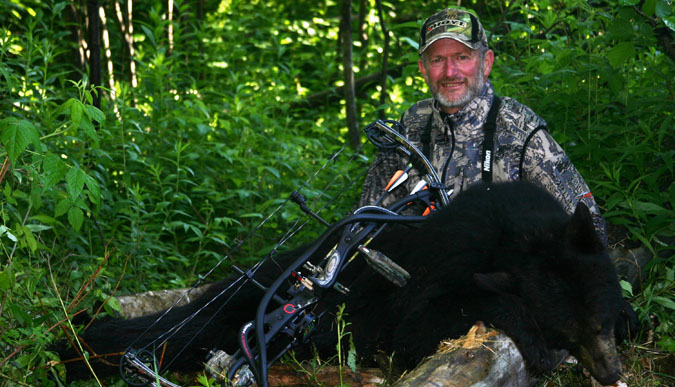
I was living in coastal Alaska then, a place thick with black bears but a region where several pretty serious bear hunters live. The older bears have been educated to a degree, and it takes some stealth to get them to come to your bait station when someone is on stand. All my pre-season scouting had pointed to a small, tight creek draining out of the tall mountains that fed the mighty Copper River as being a spot to get some sure-fire action. After walking the creek during the previous fall, I settled on a brush-choked flat as the spot to set a tree stand over bait the next spring. I was confident it would pay off, in spades.
To make a long story short, the site proved to be a hot one. My trail timers (this was back before digital trail cameras, so we used the early timers that only recorded a number each time something broke the beam of light as it passed near the bait) showed over 400 hits in one week. Bingo! Yet in all my hunting time there I only saw a couple of small boars and one sow with cubs – never one of the big studs that were leaving six-inch wide tracks nearby.
The problem, I soon discovered, was that my stand was set in the right drainage, but exactly the wrong place. Here’s where I went wrong, and how you can avoid the same pitfalls.
· The Setting Sun: While I have shot black bears off baits at all hours of the day, by far my best success has come in the evening. The way that my chosen stand site in this case laid out, I had to set my stand in a spot where the setting sun would silhouette my tree stand against a background that made it easy for an approaching bear to spot any sort of movement. In Alaska in spring, you are going to be moving some thanks to the gazillion biting bugs. Bad choice.
· Pooling Scent: The biggest bugaboo here was the fact that the stand was set in a depression. This allowed my scent to pool itself in the bottom, near the bait itself. Any prolonged sits on stand – and I usually sit at least 4-5 hours at a crack – meant that despite my best efforts at scent control, at least some of my smell would be lingering in the strike zone.
· Swirling winds: Afternoon breezes are common in Alaska. On one side of this set-up was a tall, thick stand of mixed spruce and cottonwoods backed by a rocky shale slope. I had chosen my stand site partially because this natural roadblock would help funnel approaching bears from the other direction. While that part of the plan was spot-on, the afternoon winds would hit the trees and mountainside and bounce back in an erratic fashion, spreading my scent trail all over Hell’s half acre.
Bear Hunting Lesson Learned
The next spring I hunted the same creek, but moved my stand site just 200 yards downstream. Here the creek had widened out just a little bit, and the area was generally flat for a couple hundred yards on all sides of the bait site.
I like to set bear baits next to creeks for several reasons.
1. Spring bears need water, and you can find all sorts of fresh new grasses and other plants they love to eat growing near the water.
2. Creeks are one of the first places in the Far North that thaw in spring, and thus the first places to have new plant growth, meaning that bears out of the den first – usually older boars -- will come to them right off the bat.
3. Creeks also make noise, which helps mask any sounds I make both approaching my stands for an evening sit and inadvertent noises I make while on stand.
4. The creeks help force evening breezes to blow in a relatively constant direction, meaning I can set my ambush accordingly.
5. Creeks often flow through areas naturally thick with streamside brush, giving older bears the security cover they need to feel comfortable both living nearby and approaching the bait itself.
I also learned that there are days when the winds are going to get squirrelly, and when this occurs you back off and wait to hunt the bait another day. If you have a big bear frequenting a particular bait, the chances are very good that as long as you keep him fed, he’ll keep coming if you do not spook him off.
Why risk it by hunting a marginal day when you have all the time in the world?
That spring I ended up taking a beautiful boar with some age on him. And to show you that this system works no matter where you are, in spring 2010 I shot a very nice black bear in Quebec over a bait setup under the exact same conditions.
It’s all good.






